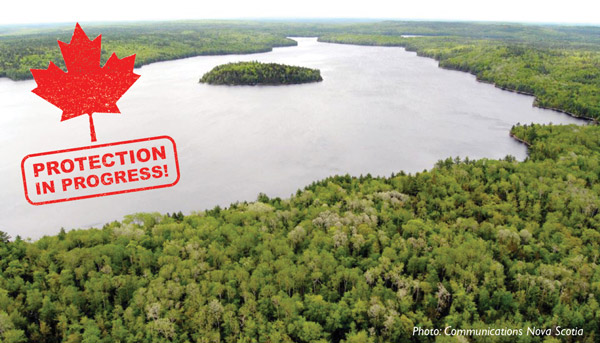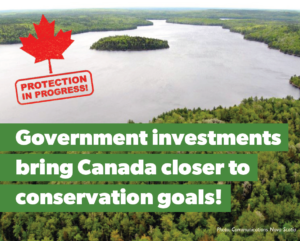It’s been two years since the federal government announced the biggest-ever investment to protect nature in Canadian history. And it’s working. Across Canada we’re seeing tangible progress – from 27 new protected areas in Nova Scotia to 50,000 km2 of Indigenous-led conservation in northern Manitoba, and from Canada’s newest national park in Northwest Territories to a doubling of protected area in New Brunswick. (Scroll down for the latest success stories.)
More is needed.
As federal, provincial, territorial and Indigenous governments and other partners like CPAWS work together to deliver on the goal of protecting at least 17% of our land and freshwater by 2020, we need also to focus on where we go next.
Imagine what we can protect next…
Getting to Canada’s new goals of 25% protection by 2025 and 30% by 2030 will take more leadership, including more investment by the federal government. The historic investment of 2018 is working. Let’s keep going!
Success Stories
Canada’s Newest National Park Reserve and Indigenous Protected Area in NWT

Federal Funding Helps Establish Canada’s Newest National Park Reserve and Indigenous Protected Area!
Lutsel K’e, NWT – After decades of work, Thaidene Nëné, which means “Land of the Ancestors” in the Denesuline language, is a protected area! Located at the east arm of Tu Nedhé (Great Slave Lake) and spanning over 26,000 sq km, Thaidene Nëné will protect the habitat of grizzly bears, wolves, moose and muskox as well as the critical winter grounds for the last herds of barren ground caribou. Importantly, Thaidene Nëné will be governed by Łutsël K’é Dene First Nation in partnership with Parks Canada and the Government of the Northwest Territories, and will provide the opportunity for Łutsël K’é Dene to share their culture with Canada and the world by owning and operating world-class hiking and fishing lodges in the protected areas.
Thaidene Nëné will be governed by Łutsël K’é Dene First Nation in partnership with Parks Canada and the Government of the Northwest Territories.
An investment of $15 million by the federal government into a $30 million trust fund will allow Łutsël K’é Dene to manage Thaidene Nëné and support both community stewardship and economic diversification in the Łutsël K’é community.
Twenty-seven New Protected Areas in Nova Scotia

Challenge Fund Leads to 27 New Protected Areas in Nova Scotia
Halifax – Thanks to support from the Challenge Fund, in September 2019, the Nova Scotia government announced the creation of 27 new protected areas, adding approximately fourteen thousand hectares of public land toward the provincial system of protected areas. Included in the announcement are several high priority sites for conservation, including St. Mary’s River, Mabou Highlands, Katowe’katik, and St. Margaret’s Bay Islands. Together, these new protected areas protect large intact forests, coastal ecosystems, species-at-risk habitat, important wetlands, and significant waterways. They contain several populations of rare species, including wood turtles, Atlantic salmon, Blanding’s turtles, eastern ribbon snakes, piping plovers, and Atlantic coastal plain flora.
These new protected areas protect large intact forests, coastal ecosystems, species-at-risk habitat, important wetlands, and significant waterways.
Nova Scotia’s decision to legally-designate these high-priority conservation sites would not have occurred without the funding provided by the Challenge Fund. It is a great example of how different levels of government can work together to protect important natural areas that are crucial for biodiversity conservation.
Exciting Announcement in New Brunswick

Government of New Brunswick Makes Exciting Announcement Stimulated by Challenge Fund
Fredericton – In October of 2019 the Government of New Brunswick announced that it would protect 10% of the province – an exciting announcement considering that reaching that goal would more than double the amount of protection in the province! Currently, New Brunswick has the second lowest percentage (4.6%) of protected land of any province or territory in Canada.
With help from the Challenge Fund, New Brunswick announced it will double the amount of protection in the province.
In addition to receiving Challenge Fund monies to support new protected area creation, the provincial government received thousands of letters from New Brunswickers in response to public campaigns by CPAWS and our colleagues supporting increased protection of New Brunswick’s natural spaces.
Following their announcement, the government began consultations on protecting the beautiful Restigouche Wilderness Waterway, an area CPAWS has worked to protect for years. The government has listened to New Brunswickers on this critical issue! The future is bright for the province.
Ts’udé Nilįné Tuyeta Protected Area in NWT

Challenge Fund Helps to Protect the Ts’udé Nilįné Tuyeta Protected Area
Yellowknife – In November of 2019 a Challenge fund investment of $6.2 Million was announced to support completion of establishment agreements for the Ts’udé Nilįné Tuyeta Protected Area (also known as the Ramparts River and wetlands). Ts’udé Nilįné Tuyeta includes 10,050 sq km of K’asho Got’įnę traditional territory and is an area of abundant wildlife, fish, birds, caribou, moose, and furbearing animals.
Ts’udé Nilįné Tuyeta is an area of abundant wildlife, fish, birds, caribou, moose, and furbearing animals.
The Canadian Parks and Wilderness Society’s NWT Chapter extended its congratulations to the K’asho Got’įnę Dene and Métis, the Government of the Northwest Territories, and the many partners who celebrated the signing of the establishment agreement. This Challenge Fund investment is assisting in the first five years of operation of the protected area as well as the development of regulations and the protected area’s management plan.
Protecting Traditional First Nation Territory in Manitoba

Manitoba First Nation Empowered to Protect Traditional Territory
Winnipeg – In the Northernmost reaches of Manitoba, the Sayisi Dene First Nation is leading an initiative to protect the 50,000-sq km Seal River watershed from industrial activity. The Seal River watershed is a pristine expanse of tundra, wetlands and forests as vast as Nova Scotia, free from permanent roads, dams, mines or industrial activity of any kind. Caribou and polar bears roam beneath massive flocks of birds near a powerful river teeming with beluga whales, seals and fish.
There are at least 23 known species at risk in the Seal River watershed, including caribou, polar bears, beluga whales, wolverines, grizzly bears, killer whales and olive-sided flycatchers.
In August 2019 a three-year federal government grant from the Challenge Fund was announced, setting the stage for the Sayisi Dene First Nation to protect, manage and steward their traditional lands. The Sayisi Dene First Nation, the only community located within the watershed, are working with neighbouring First Nations, the Inuit in Nunavut, and the CPAWS Manitoba chapter as well as other NGOs on the project.
Protecting Innu Culture in Québec

Challenge Fund Monies Protecting Innu culture in Québec
Pipmuacan – Woodland caribou have been at the heart of the culture of the Innu First Nation of Pessamit for millenia. Innu knowledge, language and spirituality are fundamentally linked to caribou and their habitat, which is currently threatened in Quebec by industrial forestry activity. Thanks in part to a grant from the Challenge Fund, the Pessamiulnut have affirmed their intention to protect an area called Pipmuacan in the Côte-Nord region of Quebec through a public call for protection to the Government of Quebec.
When protected, this area will help Quebec reach 17% land protection by 2020.
When protected, this area will help Quebec reach 17% land protection by 2020, an objective that the Government of Quebec committed to reach by the end of 2020. In their public statement, the Pessamiulnut declared that “caribou and the land are the nucleus of our culture. They structure our thoughts, shape our being, our values and our spirituality. Without them we no longer exist.” Protecting Pipmuacan would protect an area that is essential for maintaining the Innu culture and identity. SNAP Quebec continues to work with the Innu First Nation of Pessamit to support this important work.

